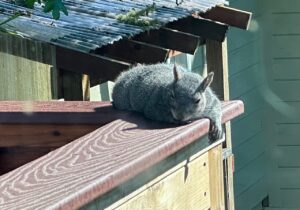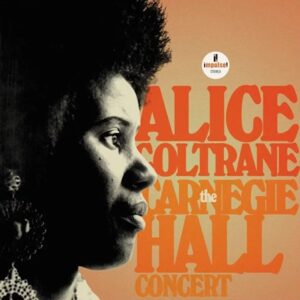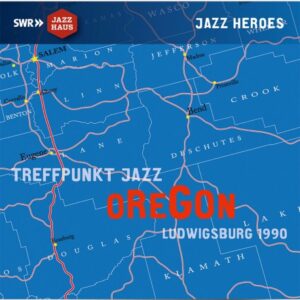“Music For Black Pigeons“

I bought my copy of „Music for Black Pigeons“ a number of months ago, watched it and was very moved by it. But it wasn’t until I revisited it yesterday during a break in a session of free playing with a talented percussionist that I fully appreciated it. Seeing it with a fellow artist allowed me to see it with fresh eyes and ears.After viewing it a second time, I realized just how artfully this film is executed. It is more than just merely another music documentary; it is really a humanistic art film that focuses on aging, love and the shared passion for artistic collaboration. And of course, always the beautiful music.
While the film centers of guitarist Jakob Bro, the beating heart of this film is in the elder players who recognized his talent and wanted to play with the young Danish maestro. Structurally, the film takes its time, setting the scene for each location, lingering on buildings or street scenes, giving the viewer a sense of place and atmosphere before diving into the more intimate scenes.
The brilliant direction and editing takes advantage of the nearly 15 years of filming, exploring the themes of aging and the palpable love between collaborators, which in many cases resulted in lifelong friendships. All of this moves back and forth in time, revealing the personalties of each player through fly on the wall moments in the recording studio and on stage.
Punctuating these vignettes are revealing interviews with many of the players. Unlike many such films, the questions are probing, the answers provocative and often profound. As a lifelong musician with a long career in music, I found the artists’ struggle to answer these questions relatable and incredibly insightful.
There are so many highlights it’s hard to pick just a couple. I loved every moment Lee Konitz is onscreen. He is painfully honest and real, and his humbleness is completely genuine. Here is a guy who has been a part of so many scenes in several important eras, and still demonstrates a childlike beginner’s mind in relation to Bro’s contemporary approach to modern music, and even though he admits to not fully understanding what’s going on, nonetheless embraces the moment and throws himself into the music wIth spontaneity, imbuing every note in each solo with meaning, great heart and wisdom. Just watching the love and recognition amongst his peers, especially the look on Jakob Bro’s face as Lee overdubs a brilliant solo that can only come from a lifetime of dedication to his craft, is worth the price of admission.
I also loved the portrait of nerdy bassist Thomas Morgan as we watch his morning regimen, getting on the PC (programming in DOS no less,) to cue up an incredibly diverse program of music while he performs his morning stretches and his own peculiar variations on yoga postures, then selecting his clothes for the day. Delightful as is his quirky interview, which starts off with one the longest pauses in documentary history.
There are a great many musicians featured in this documentary. From memory and in no particular order: Bill Frisell, Thomas Morgan, Joe Lovano, Joey Baron, Paul Motian, Jorge Rossy, Craig Taborn , Palle Mikkelborg, Arve Henricksen, the late John Christiansen, Mark Turner, Andrew Cyrille and several others. A number of these artists are also interviewed, as well as the ones I mention here.
I don’t want to give too many things away here for those who haven’t had the pleasure of viewing this film, but I will also add that the beautiful scene with Manfred Eicher in the studio with Bro and compatriots recording Bro’s tune dedicated to Tomacz Stanko, really touched my heart. The camera wanders around the control room and rests on a picture of a younger Eicher and Stanko and other photos from a decades long association. In his interview, Manfred Eicher tries to express his feeling about his many years in the recording studio with Stanko, finding himself at a loss for words, before he is finally overcome with emotion and unable to continue.
In the end, this film is a poignant portrait of elder musicians with really young hearts meeting with a younger generation of open creative artists, who are still willing to exploring the edges of creative boundaries, even towards the end of their lives. The film also makes it clear that it’s the music that transcends the disparities of race, age, gender and cultural origins. All of these differences are ultimately superficial when artists come together with a common purpose.
I want to add that this film looks absolutely gorgeous; even though it was released on DVD, it looks as good (and sometimes better) as many of my BluRay discs. I honestly don’t know how they pulled that off, but they did. Also the sound, which is in Dolby Digital, sounds equally amazing, as good as many uncompressed Master Audio HD soundtracks in my Bluray collection.
A Tale of Woodpecker Woes

Acorn Woodpeckers are a common Northern California sight. With their distinctive red caps atop their heads, these adorable, agile little birds have been chattering in and around the oaks that surround my woodland retreat since I moved to the hills of Forestville, CA, some 25 years ago. I have always enjoyed watching their antics – such busy, comical characters. I also love listening to their humorous laughing calls. They are active, energetic and good natured creatures. They are clannish and extremely social; families of acorn woodpeckers live and work together, their sole purpose in life (beside procreation) being to gather and store acorns. Their strong beaks and neck muscles allow them to easily pierce thru most wood; they spend a good part of their lives drilling large holes in which to store their precious bounty.
As winter approaches, they are busy picking up acorns and piling them up, huge aggregations mounting under a nearby telephone pole that is so riddled with holes the power company had to replace it. They kindly left part of the old one attached so the woodpeckers could continue their one-pointed mission.
After the acorns are stacked up and the holes are drilled for the new crop, the woodpeckers get busy picking them up one by one and slotting them into each hole. It is a painstaking, time-consuming activity, one they never seem to complete.
I used to think the acorns themselves were food for the critters, but I was wrong: acorns aren’t really meant to be eaten just as they are. The acorns attract small insects, which burrow into them. When they are full of yummy bugs, the woodpeckers retrieve the acorns and consume them. It’s a marvel that they can remember where every single one is.
There used to be a season for each activity, but with climate change, the acorn woodpeckers seem to be focused on nut gathering year round. Apparently, there can never be enough holes drilled or acorns socked away for a rainy day.
One fall, the acorn woodpeckers decided my home was fair game. They started drilling into the trim pieces on the sides of my house. Whereas I always enjoyed their antics, I soon realized I had to draw a line in the sand. This was war.
I puzzled over my options. I half-heartedly threw pebbles at them. I banged on the walls and windows. Nothing deterred them. Then I got a brilliant idea – a slingshot. I realize this sounds cruel, but my intention wasn’t to harm them, just to scare them away. I did my research and discovered there were little clay pellets used for target practice, so I purchased an intermediate slingshot along with a large bag of these lightweight pellets.
At first I was an awful shot. But eventually I got good enough to hit the metal downspout at the corner of my house where they were pecking away. That scared them off, at least for a while. I would sneak down the side of my house and aim for the downspout. One day, while I was engaged in that activity, just when I was about to take my shot, a tiny face peered around my neighbor’s fence and made an uncharacteristic repetitive screeching sound, alerting the woodpecker pecking on the corner of my house – it immediately flew away. I realized they were working together on this; the little fuckers now had spotters.
In all the years I have been battling these persistent creatures, I have only hit one once. When I did hit the little guy, he fluttered his feathers indignantly and turned towards me with a look that seemed to say “How dare you?!” He then flew away unharmed. That kept them away for a while. But they soon returned.
It became clear that my efforts with the slingshot were yielding diminishing returns. The clever little monsters anticipated my every move. They warned one another and were so aware of my presence, I could barely get off a single shot.
Thinking perhaps my trim pieces were old and easily penetrable, I replaced them with harder wood. But the new ones I installed (at no small expense) did not stop them for a second.
So I developed a new strategy. I decided, if they were going after me in my home, I would go after them in theirs. I began going out on my deck and taking pot shots at them hanging about in their favorite staging grounds, several venerable oaks in my backyard.
As I was still a terrible shot, I didn’t hit them in their trees or even come close. But I was at least good enough by now to annoy them, and after a while they would leave those trees, at least for a while. But they always came back to peck on my house, especially when I was out. I found that consistency was the key. If I responded promptly to each and every attack, going after them “where they lived”, they would eventually get the idea. It sort of worked.
After a hard day’s work, these creatures like to congregate at twilight in a spreading oak tree on my neighbor’s property. There they socialize, laugh at each other’s jests, get into arguments and presumably recount the day’s exploits. “That was a tough hole to make”, “ That asshole human isn’t worth the trouble. Doesn’t he have anything better to do with his time?” “Those squirrels are taking over this tree – we must chase them off!”
Indeed, the squirrels are the acorn woodpeckers real nemesis -after all, they are competing for the same treasures. Although to be fair, the acorn woodpeckers are the real trouble makers. Each day I watch the poor squirrels just trying to live their lives, getting kamikazied and chased away by sharp beaked dive bombers. The beleaguered animals are rarely left alone to enjoy themselves. Oftentimes after being harassed, these poor creatures take shelter on my upper deck, the only place they are safe from the attacks. There they take in the sun and relax, safe at least for a little while from the constant harassment.

Over time, I began to identify with the squirrels’ plight. Like mine, their safe homes were also being unjustly invaded. I surmised there really were enough acorns to go around for all. But acorn woodpeckers are an obsessive lot and definitely not socialists; they are survivalists and, worse, hoarders. For these creatures, there can never be enough acorns and never enough holes in which to deposit them. I began to develop a real empathy for the squirrels. And when they wearily climb onto my deck railing, I give them a sympathetic wave. It was when (I swear) I saw one conspiratorially wink at me that I suddenly knew what the next stage of my woodpecker strategy had to be: a squirrel/human alliance.
Those red-capped fuckers will never know what hit them.
Alice Coltrane Carnegie Hall Concert

First of all, I find it amazing this fine 1971 concert recording has never seen the light of day. This set was part of an eclectic concert lineup that could only have been programmed in this period of odd juxtapositions. The evening this was recorded, Alice Coltrane was opening for none other than Laura Nyro and the Rascals. Her landmark album, Journey in Satchidananda had just been released and Impulse was hoping for a boost on record sales and perhaps a live companion album to the new studio release.The lineup for this band is impressive: Besides the inimitable Ms Coltrane on harp and piano, Pharoah Sanders and Archie Shepp are in the front line, both Cecil McBee and Jimmy Garrison are on bass, with no less than three percussionists as well, Ed Blackwell, Clifford Jarvis and Kumar Kramer. Together, what a joyful noise this band makes!
Alice Coltrane was so far ahead of her time, this music still sounds startlingly fresh today. Unlike her recordings, the drums and percussion are in the forefront here, thus giving this recording a more propulsive vibe than her studio albums which feature harp.
For the first two pieces, swirling harp glissandos and percussion bathe the listener in waves of beauty, lulling the listener into a meditative state, that is, until John Coltrane’s Africa rouses the audience with a potent percussion ensemble solo, followed by Coltrane’s pounding piano chords and dueling growling solos from Sanders and Schepp. After the sax solos comes a powerful Coltrane piano solo following by an explosive ensemble drums and percussion solo. The mood suddenly becomes ruminative as Garrison and McBee take the floor quite literally with an extended bass solo. The bass solos eventually evolve into a low end groove that even briefly gets the audience clapping along. One of my favorite moments is when Coltrane comes back in with a grooving ostinato, followed by Sanders and Shepp’s vocal-like screams – shouts of joy and pain explode across the aural firmament. The concert closes with another John Coltrane composition, Leo, which takes the fierce ecstatic intensity up another level, Sanders and Schepp channeling the late sax player’s cosmic wails in a cacophony of deep spiritual yearning.
As wonderful as the solos are, perhaps the best moments are when the band is just in playing together in the sound space and grooving. This is trance music of the highest order. It really takes the listener on a journey into cosmic bliss.
In a way, this release seems perfectly timed. There has been renewed interest in Alice Coltrane’s music in recent years and for good reason: in these chaotic, divisive and violent times, we need this music more now than ever. Recently, there have been several tribute concerts in the US. The most notable is harpist Brandee Younger’s 4 night residence @ SF Jazz, where one evening she even brought in a small string section to perform some of this music. It’s great to see the tradition carried on.
When I was a teen, I was drawn to this music without knowing why. Something in my soul knew I needed this medicine, for medicine is exactly what this music is. This kind of spiritual jazz has always had a special place in my heart. This album is a wonderful gift to those of us who grew up with this music and a great introduction to the uninitiated. Sound quality is fantastic, especially in Hirez.
Oregon Treffpunkt Jazz 1990

Oregon’s newly released live album, Treffpunkt Jazz, Oregon Ludwigsburg 1990, is the only official Oregon live album that features Trilok Gurtu on tablas and percussion. Like many Oregon fans, I am a diehard appreciator of the early Oregon albums with Colin Walcott on percussion. Nonetheless, I also have a great appreciation for the work that Trilok did during his time with the band. Gurtu is a powerhouse. His tabla playing is hard to beat, although he is perhaps not quite the master of colors that Colin was, who was a poet in his intuitive sensibilities; he always seem to know just the right thing to play at the right moment. That being said, Trilok is no slouch on his extended percussion setup.
The repertoire on this album ranges from the early Silence of a Candle, through classic Oregon standbys such as the Jim Pepper peyote chant inspired Wichi-Tai-To (first recorded on Winter Light and several times afterwards,) and June Bug (Roots in the Sky,) and extends through the album 45th Parallel, with the marvelous Towner compositions Les Douzilles and Hand in Hand. My favorite performance thus far from this sprawling two CD set is Yet to Be, originally recorded on Northwest Passage – it’s a joyful romp, performed with great aplomb and enthusiasm. Also, Waterwheel (Out of the Woods,) is superbly presented here. Tempos on both of these tunes are brisk, and the performances are inspired and adventurous, yet tight and precise.
Note, this album is from 1990 and thus, Ralph Towner’s fascination with synthesizers is on full display here. Some people objected to the addition of electronic textures to the band’s signature acoustic sound. This may put off the fans of earlier Oregon albums. However, in this listener’s opinion, for the most part, the synths are deployed tastefully and generally do not dominate, nor do they detract.
I feel this album is very representative of the sound of the band in the early 90s, and rather than just being an interesting oddity, primarily targeting Oregon diehards desperate for anything new from the band, I consider it a wonderful addition to the Oregon catalog and an essential gift to any fan.
The recording quality here is nothing short of stellar. In my opinion, this is one of the best Oregon live albums ever released. Perhaps only the earlier In Concert comes close in terms of overall performance and audio fidelity, although I honestly prefer the sound of this recording over any of their previous live releases.